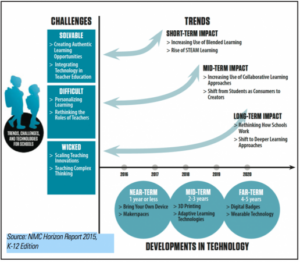 This summer the New Media Consortium (NMC), together with the Consortium for School Networking (COSN), released their annual K12 Horizon Report, a document which can be very informative for manufacturers and integrators in the display industry. According to the NMC, ‘The NMC Horizon Report series charts the five-year horizon for the impact of emerging technologies in school communities across the globe.’
This summer the New Media Consortium (NMC), together with the Consortium for School Networking (COSN), released their annual K12 Horizon Report, a document which can be very informative for manufacturers and integrators in the display industry. According to the NMC, ‘The NMC Horizon Report series charts the five-year horizon for the impact of emerging technologies in school communities across the globe.’
This report has been around for a long time: ‘With more than 13 years of research and publications, it can be regarded as the world’s longest running exploration of emerging technology trends and uptake in education.’ The full report can be accessed here (http://tinyurl.com/nderyxj).
Dissecting this report helps not only with an understanding of the extant educational marketplace, but more importantly, it supplies some of the key ideas that will help your message resonate with educational customers, world-wide. The following chart helps lay out the big ideas in this report.
Although the report largely speaks for itself, in this piece I will offer a bit of translation for and connection to leaders in the large and mobile display industry. With full disclosure I must mention that I served as one of the 56 panelists who developed this report over many months. Serving as an expert panellist for the 2015 Horizon K12 report, I think I can add beneficial nuance to the findings, from an inside perspective. Report findings and my commentary follow.
Important predictive developments in technology for K12 schools worldwide.
Near-term (1 year or less)
- Bring your own device (BYOD)
- Makerspaces
BYOD is expected to come into its own this year. It already seizes a large part of the mindshare at educational conferences, no doubt due to the fact that purchasing devices can be outright cost-prohibitive for school districts. So why not tap into the personal devices each student brings with them to school instead? That is the thinking. Tools that work well in a BYOD environment are likely to be more successful. Devices coupled with management tools to make the integration process easier for IT departments, schools and teachers will certainly do even better. Understanding what your customers are facing, and working to soften the challenges they will inevitably experience in a BYOD environment, will set your company on very positive footing.
Mid-term (2-3 year outlook)
- 3D Printing
- Adaptive Learning Technologies
Adaptive learning technologies include software platforms that adapt themselves to individual student learning needs, as they are learning. Smart software, if you will. Smart enough to know where kids are at, help them when they struggle and move them on when they are proficient. And here’s the good news: they will still need displays. Adaptive learning technologies run on mobiles, tablets, and computers. In some cases, this will bring labs back into play, while in other cases, individual student devices will access this new resource. Since this is rapidly becoming the next generation of software in schools, it will serve you well to show your products running these types of solutions in exhibit halls; to ensure technical compatibility with some of the major adaptive learning players; and to use this verbiage when speaking with teachers and administrators.
Far-term (4-5 year outlook)
- Digital Badges
- Wearable technology
Okay, five years out is a long time, but the idea that educators are keenly scrutinising wearable technology developments should delight mobile display manufacturers. Still, no-one quite knows for sure what wearable technology will look like in education. The obvious role is in physical education. But who knows? Perhaps a school safety role may be served by wearable technology, if the privacy gremlins do not impede.
In my next instalment, I am going to continue this discussion by addressing some of the current ed tech trends the 2015 K12 Horizon report sees as shaping your business environment. Stay tuned.
–Len Scrogan

